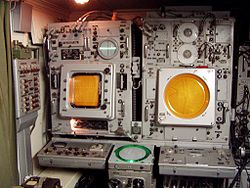 P-12 "Spoon Rest A" operating in Somalia | |
| Country of origin | |
|---|---|
| Introduced | 1956 |
| Type | Early Warning Ground Control |
| Frequency | VHF |
| Range | 200 km |
| Altitude | 25 km |
| Azimuth | 360 degrees |
| Precision | 1 km range |
| Power | 180 kW |
The P-12 "Yenisei" (also referred to by the NATO reporting name "Spoon Rest A" in the west) was an early VHF radar developed and operated by the former Soviet Union.

